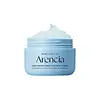What's inside
What's inside
 Key Ingredients
Key Ingredients

 Benefits
Benefits

 Ingredients Side-by-side
Ingredients Side-by-side

Water
Skin ConditioningGlycerin
HumectantC18-21 Alkane
Solvent1,2-Hexanediol
Skin ConditioningNiacinamide
SmoothingSimmondsia Chinensis Seed Oil
EmollientPolyglyceryl-3 Methylglucose Distearate
EmulsifyingButylene Glycol
HumectantPanthenol
Skin ConditioningSodium Carbomer
Emulsion StabilisingHydroxyacetophenone
AntioxidantEthylhexylglycerin
Skin ConditioningAdenosine
Skin ConditioningTrisodium Ethylenediamine Disuccinate
Hydrogenated Lecithin
EmulsifyingCeramide NP
Skin ConditioningMalachite Extract
AntioxidantArginine
MaskingPEG-10 Rapeseed Sterol
CleansingSodium Hyaluronate
HumectantAloe Barbadensis Leaf Extract
EmollientDipropylene Glycol
HumectantOryza Sativa Extract
AbsorbentGlyceryl Stearate
EmollientGlycereth-20
HumectantCamellia Sinensis Leaf Extract
AntimicrobialOryza Sativa Lees Extract
Skin ConditioningAnthemis Nobilis Flower Extract
MaskingTocopherol
AntioxidantHydrolyzed Hyaluronic Acid
HumectantLactobacillus/Rice Ferment
Skin ConditioningCaprylyl Glycol
EmollientCentella Asiatica Extract
CleansingSodium Dna
Skin ConditioningSodium Acetylated Hyaluronate
HumectantDisodium EDTA
Tripeptide-1
Skin ConditioningAcetyl Hexapeptide-8
HumectantCopper Tripeptide-1
Skin ConditioningPalmitoyl Pentapeptide-4
Skin ConditioningHexapeptide-9
Skin ConditioningBromelain
Skin ConditioningOryzanol
Skin ConditioningPapain
Skin ConditioningProtease
ExfoliatingLipase
Skin ConditioningKojic Dipalmitate
EmollientWater, Glycerin, C18-21 Alkane, 1,2-Hexanediol, Niacinamide, Simmondsia Chinensis Seed Oil, Polyglyceryl-3 Methylglucose Distearate, Butylene Glycol, Panthenol, Sodium Carbomer, Hydroxyacetophenone, Ethylhexylglycerin, Adenosine, Trisodium Ethylenediamine Disuccinate, Hydrogenated Lecithin, Ceramide NP, Malachite Extract, Arginine, PEG-10 Rapeseed Sterol, Sodium Hyaluronate, Aloe Barbadensis Leaf Extract, Dipropylene Glycol, Oryza Sativa Extract, Glyceryl Stearate, Glycereth-20, Camellia Sinensis Leaf Extract, Oryza Sativa Lees Extract, Anthemis Nobilis Flower Extract, Tocopherol, Hydrolyzed Hyaluronic Acid, Lactobacillus/Rice Ferment, Caprylyl Glycol, Centella Asiatica Extract, Sodium Dna, Sodium Acetylated Hyaluronate, Disodium EDTA, Tripeptide-1, Acetyl Hexapeptide-8, Copper Tripeptide-1, Palmitoyl Pentapeptide-4, Hexapeptide-9, Bromelain, Oryzanol, Papain, Protease, Lipase, Kojic Dipalmitate
Avena Sativa Seed Water 77%
SolventButylene Glycol
HumectantGlycerin
Humectant2,3-Butanediol
Humectant1,2-Hexanediol
Skin ConditioningWater
Skin ConditioningAmmonium Acryloyldimethyltaurate/Vp Copolymer
Squalane
EmollientHydroxyacetophenone
AntioxidantCarbomer
Emulsion StabilisingDipotassium Glycyrrhizate
HumectantPanthenol
Skin ConditioningTromethamine
BufferingEthylhexylglycerin
Skin ConditioningInulin Lauryl Carbamate
Emulsion StabilisingSodium Surfactin
CleansingBeta-Glucan
Skin ConditioningAvena Sativa Seed Water 77%, Butylene Glycol, Glycerin, 2,3-Butanediol, 1,2-Hexanediol, Water, Ammonium Acryloyldimethyltaurate/Vp Copolymer, Squalane, Hydroxyacetophenone, Carbomer, Dipotassium Glycyrrhizate, Panthenol, Tromethamine, Ethylhexylglycerin, Inulin Lauryl Carbamate, Sodium Surfactin, Beta-Glucan
 Reviews
Reviews

Ingredients Explained
These ingredients are found in both products.
Ingredients higher up in an ingredient list are typically present in a larger amount.
1,2-Hexanediol is a synthetic liquid and another multi-functional powerhouse.
It is a:
- Humectant, drawing moisture into the skin
- Emollient, helping to soften skin
- Solvent, dispersing and stabilizing formulas
- Preservative booster, enhancing the antimicrobial activity of other preservatives
Butylene Glycol (or BG) is used within cosmetic products for a few different reasons:
Overall, Butylene Glycol is a safe and well-rounded ingredient that works well with other ingredients.
Though this ingredient works well with most skin types, some people with sensitive skin may experience a reaction such as allergic rashes, closed comedones, or itchiness.
Learn more about Butylene GlycolEthylhexylglycerin (we can't pronounce this either) is commonly used as a preservative and skin softener. It is derived from glyceryl.
You might see Ethylhexylglycerin often paired with other preservatives such as phenoxyethanol. Ethylhexylglycerin has been found to increase the effectiveness of these other preservatives.
Glycerin is already naturally found in your skin. It helps moisturize and protect your skin.
A study from 2016 found glycerin to be more effective as a humectant than AHAs and hyaluronic acid.
As a humectant, it helps the skin stay hydrated by pulling moisture to your skin. The low molecular weight of glycerin allows it to pull moisture into the deeper layers of your skin.
Hydrated skin improves your skin barrier; Your skin barrier helps protect against irritants and bacteria.
Glycerin has also been found to have antimicrobial and antiviral properties. Due to these properties, glycerin is often used in wound and burn treatments.
In cosmetics, glycerin is usually derived from plants such as soybean or palm. However, it can also be sourced from animals, such as tallow or animal fat.
This ingredient is organic, colorless, odorless, and non-toxic.
Glycerin is the name for this ingredient in American English. British English uses Glycerol/Glycerine.
Learn more about GlycerinHydroxyacetophenone is antioxidant with skin conditioning and soothing properties. It also boosts the efficiency of preservatives.
This ingredient is not irritating or sensitizing.
Panthenol is a common ingredient that helps hydrate and soothe the skin. It is found naturally in our skin and hair.
There are two forms of panthenol: D and L.
D-panthenol is also known as dexpanthenol. Most cosmetics use dexpanthenol or a mixture of D and L-panthenol.
Panthenol is famous due to its ability to go deeper into the skin's layers. Using this ingredient has numerous pros (and no cons):
Like hyaluronic acid, panthenol is a humectant. Humectants are able to bind and hold large amounts of water to keep skin hydrated.
This ingredient works well for wound healing. It works by increasing tissue in the wound and helps close open wounds.
Once oxidized, panthenol converts to pantothenic acid. Panthothenic acid is found in all living cells.
This ingredient is also referred to as pro-vitamin B5.
Learn more about PanthenolWater. It's the most common cosmetic ingredient of all. You'll usually see it at the top of ingredient lists, meaning that it makes up the largest part of the product.
So why is it so popular? Water most often acts as a solvent - this means that it helps dissolve other ingredients into the formulation.
You'll also recognize water as that liquid we all need to stay alive. If you see this, drink a glass of water. Stay hydrated!
Learn more about Water